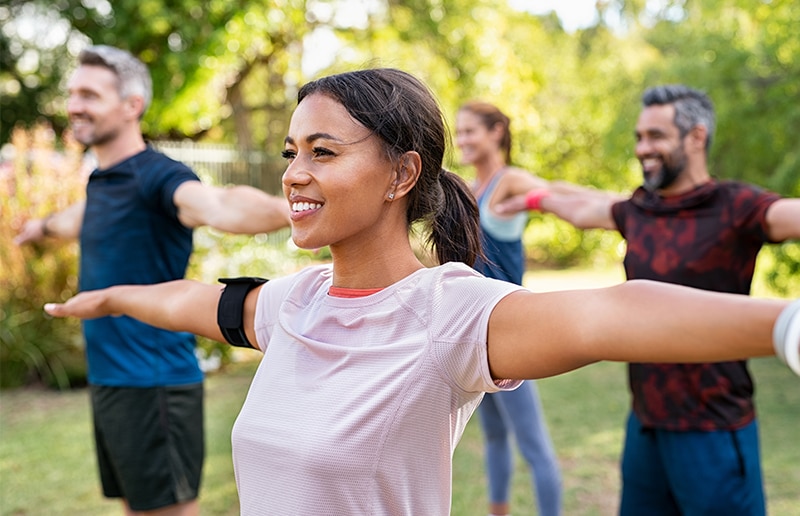As a healthcare practitioner, it’s essential to recognize the significance of athletic recovery for your patients. Whether they are professional athletes or just enjoy exercising regularly, recovery plays a critical role in their overall health and performance. In this blog post, we’ll discuss the importance of athletic recovery and provide tips on promoting it.‡
THE BENEFITS OF ATHLETIC RECOVERY
Athletic recovery is the process of allowing your body to rest and heal after physical activity. It’s essential for preventing injuries, reducing inflammation and improving performance. Here are some of the benefits of athletic recovery:
- Reduced risk of injury: When your body is fatigued, you’re more likely to get injured. Recovery helps reduce the risk of injury by allowing your body to repair and rebuild.
- Improved performance: Recovery is essential for improving performance. When your body is well-rested, you can perform at your best.
- Inflammation management: Inflammation is a natural response to physical activity. The key is maintaining a balanced inflammatory response. Effective recovery techniques help to promote balanced inflammatory responses.
- Prevention of overtraining: If you aren’t paying attention, overtraining can strike without notice, negatively impacting performance, sleep, energy, motivation and eating patterns.
FACTORS OF RECOVERY
When looking at the actual factors associated with recovery, it is important to understand the underlying physiology to effectively monitor objective markers that can quantify whether or not a patient is recovering from their efforts. Some of the factors include:
- Normalization of physiological functions like blood pressure and heart rate
- Restoration of energy stores (blood glucose and muscle glycogen)
- Replenishment of cellular energy enzymes
NUTRITIONAL STRATEGIES PROMOTING ATHLETIC RECOVERY
As a healthcare practitioner, you can help your patients promote athletic recovery by providing them with the right strategies. Here are some recommendations:
STRESS MANAGEMENT
- Ashwagandha – An Ayurvedic herb that has been used for over 4,000 years and has been shown to moderate occasional stress.1‡
- B-Vitamins – Promote cognitive function and positive mood in addition to supporting the body’s nutrient needs during stress.2, 3‡
- Multivitamins – Under stressful states, the body has an increased need for many micronutrients and a multivitamin can be helpful to support the body’s increased needs.4‡
PROMOTE HEALTHY CYTOKINE BALANCE
- Curcumin – Curcumin has been the subject of over 3,000 studies over the past 30 years and has an extensive history of use. The remarkable breadth of applications of curcumin stem from its multifocal mechanisms involving diverse intracellular signaling pathways and the regulation of hundreds of genes involved in cytokine balance, detoxification and cellular health.5, 6, 7, 8, 9‡
PROMOTE MUSCLE RECOVERY
- Creatine – Creatine is an energy carrier that is naturally present in muscles, brain and other organs. By increasing the rate of creatine phosphorylation, ammonia and lactate levels in the blood are lowered resulting in faster recovery from exercise. It is also important for vegan and/or vegetarian athletes.10
- Magnesium – Magnesium is important for hundreds of processes throughout the body and supports muscle function and recovery. Additionally, athletes can have up to 20% increase in needs for this nutrient versus normal populations.11, 12, 13
PROMOTE CONNECTIVE TISSUE REPAIR
- Collagen – Collagen has been shown to support musculoskeletal health to help optimize performance and mobility and supports healthy cartilage and joint tissues.14
- Vitamin C – Supports the healthy production of collagen and the health of connective tissue.15
CONCLUSION
Athletic recovery is essential for preventing injuries, improving performance and promoting overall health. As a healthcare practitioner, you can help your patients promote athletic recovery by providing them with the right tools and information. Encourage rest days, provide stretching and mobility exercises, recommend proper nutrition, suggest massage and other recovery techniques and monitor progress. By doing so, you can help your patients achieve their fitness goals and live a healthier life.
REFERENCES
- Lopresti AL, Smith SJ. J of Herb Medi. 2021;28:100434.
- Cohick PL, et al. Eur J of Clin Nutr. 2011;65, 4234.
- Young LM, Pipingas A, White DJ, et al. Nutrients. 2019;11(9):2232.
- Schlebusch L, Bosch BA, Polglase G, Kleinschmidt I et al. Suid-Afrikaanse tydskrif vir geneeskunde. 2022;90(12).
- Zhang F, Altorki NK, Mestre JR, et al. Carcin. 1999 Mar;20(3):445-51.
- Santos-Parker JR, Strahler TR, Bassett CJ, et al. Aging (Albany NY). 2017 Jan 3;9(1):187-208.
- James MI, Iwuji C, Irving G, et al. Cancer Lett. 2015 Aug 10;364(2):135-41.
- Bundy R, Walker AF, Middleton RW, Booth J. J Altern Complement Med. 2004 Dec;10(6):1015-8.
- Panahi Y, Rahimnia AR, Sharafi M, et al. Phytother Res. 2014 Nov;28(11):1625-31.
- Wax B, Kerksick CM, Jagim AR, et al. Nutrients. 2021 Jun 2;13(6):1915.
- Reno AM, Green M, Killen LG, et al. J Strength Cond Res. 2022 Aug 1;36(8):2198-2203.
- Nielsen FH, Lukaski HC. Magnes Res. 2006 Sep;19(3):180-9.
- Vernon WB. Magnesium. 1988;7(5-6):234-48.
- Clark KL, Sebastianelli W, Flechsenhar KR, et al. Curr Med Res Opin. 2008 May;24(5):1485-96.
- DePhillipo NN, Aman ZS, Kennedy MI, et al. Orthop J Sports Med. 2018 Oct 25;6(10):2325967118804544.







